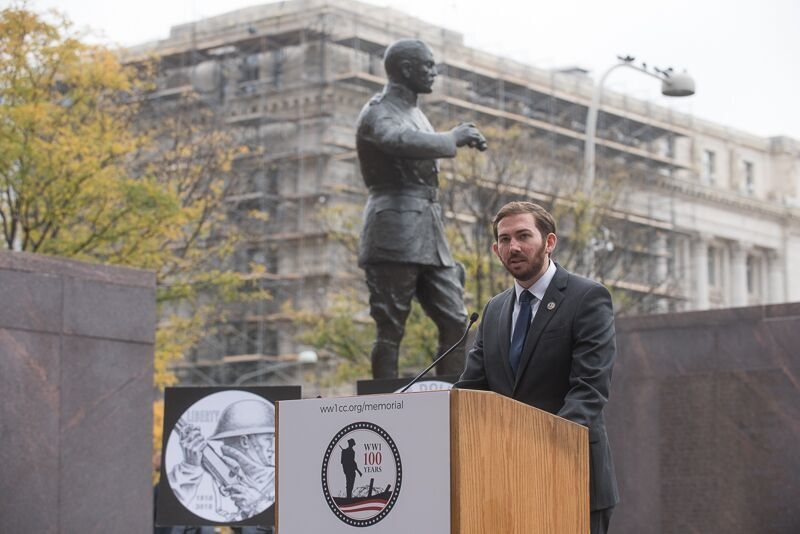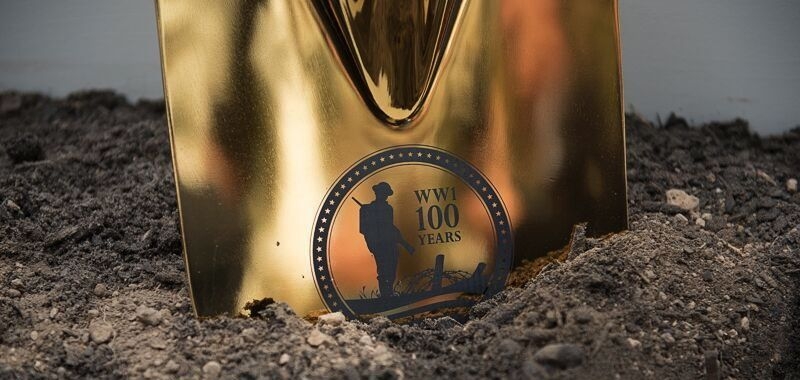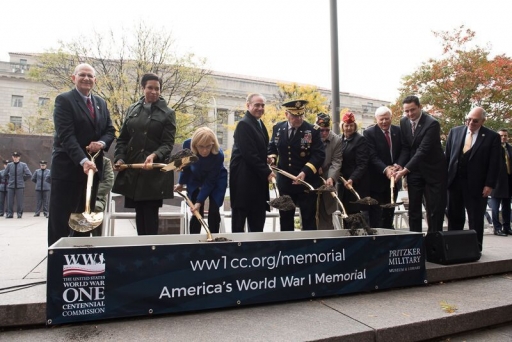America’s new National World War I Memorial has taken a significant towards becoming reality after 100 years, with a ground-breaking ceremony to get the project under way in Washington.
Guests gathered in the shadow of an existing statue of General John Pershing, US military commander in the Great War, to turn soil brought from the Meuse-Argonne, the bloodiest battle for American forces.
Sandra Pershing, from General Pershing’s family, joined Congressional, military and veterans’ representatives for the ceremony – held by the US Centennial Commission on 9 November 2017 in the run-up to Veterans Day.
The Commission also announced that the privately-funded project has received a significant financial boost, with donations of $300,000 each from the American Legion and Veterans of Foreign Wars.
‘Long-awaited’
“The World War I Memorial will be a vital and long-awaited addition”, said Washington DC Mayor Muriel Bowser, reflecting the tone of many speakers, who also included General Mark Milley, Chief of Staff of the US Army, and Veterans Affairs Secretary, David Shulkin.
Alone of major 20th century conflicts, there’s no national memorial commemorating the First World War in the US capital. Yet 116, 516 American soldiers fell in 1917-18, more than in the Korean and Vietnam wars combined.
That gap will be filled by ‘The Weight of Sacrifice’, the memorial now planned for Pershing Park, a short distance from the White House.
It will honour the 4.7 million Americans who served in the First World War after the US entered the conflict in April 1917.
 Memorial architect Joe Weishaar addressing the ceremony – behind is the existing statue of General John Pershing, commander of America’s First World War expeditionary force in France (Photo: US WWI Centennial Commission)
Memorial architect Joe Weishaar addressing the ceremony – behind is the existing statue of General John Pershing, commander of America’s First World War expeditionary force in France (Photo: US WWI Centennial Commission)
The design, chosen from more than 360 entries submitted to the Centennnial Commission, is the work of Joe Weishaar, a young architect originally from Arkansas, and New York sculptor Sabin Howard (for more on the design see Sabin Howard talks to Centenary News).
It is the ‘most noble undertaking’, says 27-year-old Joe Weishaar: “Rather than design a landmark which is pompous, ostentatious or bombastic, we find ourselves here in a small park on America’s main street,” he said.
The task, he explained, was the “creation of a memorial to a group of men and women who gave themselves in service and sacrifice without the thought of how or why or when they would be remembered.”
“It may be long overdue but today marks another point in the journey of making sure they’re not forgotten”.
 One of the presentation shovels used for the ceremonial turning of the Argonne soil (Photo:US WWI Centennial Commission)
One of the presentation shovels used for the ceremonial turning of the Argonne soil (Photo:US WWI Centennial Commission)
Terry Hamby, Chair of the Centennial Commission, thanked the American Legion and the Veterans of Foreign Wars for their latest contributions towards the memorial project.
Although created by the US Congress, the Centennial Commission operates solely through private donations.
“Our 4.7 million World War I veterans and their families are no less deserving to be recognised with a memorial, just as all veterans who have been recognised for their service in all of our nation’s other conflicts and wars,” said Mr Hamby, who served in Vietnam, and is himself the grandson of a WW1 veteran.
“As Americans we must remember their sacrifices and how their service changed the world forever.”
Source: Centennial Commission live stream
Images courtesy of the United States World War I Centennial Commission
Posted by: CN Editorial Team
